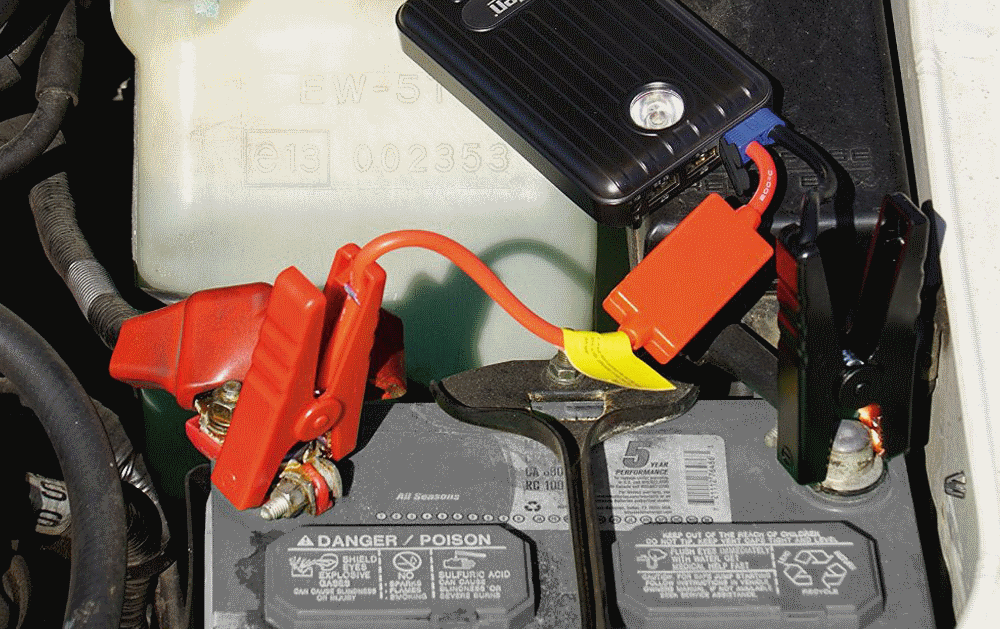A portable jump-starter allows you to quickly and conveniently jump-start a dead car battery. Portable jump-starting kits are a safer, simpler option than jumper leads.
So which one should you buy and how do you use them? Find out below.
Buying the right portable jump-starter.
We strongly recommend that you buy a portable jump-starter with reverse polarity protection. This will reduce the risk of damage to your jump-starter and your vehicle.
There are several different types of portable jump starters ranging in size and power. Many newer models are able to provide power to your mobile phone, tablet or other USB devices. They may also have a powerful LED torch.
For a standard petrol vehicle, we recommend buying a small, USB-compatible jump-starter that can fit in your glovebox. This way, it is not a hassle to take places. It will also allow charging of mobile devices in the event of an emergency.
Look at the milliamp (mAH) capacity of each jump-starter. This determines how much power the jump-starter can hold. Look for the highest amount of milliamps when buying a jump-starter. Keep in mind that a full phone charge will drain between 2000 and 3500 mAH (2-3.5 amps) from your jump-starter.
Try to find a jump-starter that displays how much battery is remaining. This way, you will know when to charge it.
Our Recommendations:
General Use
Powerall Slim Plus

This small vehicle jump-starter packs 9000 mAH of power and is small enough to fit right in your glovebox. With a built-in flashlight and USB ports, this jump-starter is great value for its price.
Heavy duty and durability
SCA 12V Jump-Starter

This heavy duty jump-starter offers durability and reliability. It also has a super bright LED worklight. For repetitive use rather than emergency use, invest in a heavy duty charger like this one. This jump-starter is perfect for garages.
Roadside Emergencies
Uniden Auto Emergency Pack

This all-in-one kit includes an 8800mAH jump-starter that functions as a portable charger and a flashlight. It also includes an air pump to inflate tyres. Ideal for long road trips, camping as well as reliability in an emergency.
Using a Portable Jump-Starter
Safety Tips:
- Always ensure that the portable jump-starter is off before connecting it to a vehicle.
- Make sure that the vehicle is completely turned off before jump-starting it. This includes the lighting, stereo and heater.
- Do not let the positive and negative leads touch.
1. Connect the jumper leads to the portable charger.
Find the supplied jumper leads that came with your portable charger. Connect them to the charger through the appropriate port.
If your portable jump-starter has an on/off switch, make sure it is off. For newer jump-starters without switches, this should not be a problem. Be sure not to let the cables touch during this process.
2. Connect the leads to the engine.
Open your car’s bonnet and locate the battery.
Next, connect the red cable to the positive (+) battery terminal. Then, connect the black cable to a stable metal point on the car’s engine or chassis. Be sure that the cables are tightly connected so that they don’t become loose and risk touching each other.
3. Begin the jump-starting process.
It is now safe to turn your jump starter’s switch on (if it has one). If not, it will already be supplying energy to your battery. Leave the jump-starter plugged into your battery for several minutes. This will ensure that the battery receives enough current to properly start your engine.
4. Test your car’s engine.
Attempt to start your engine. If it is still failing to start, leave the charger connected to your vehicle for longer.
Once the vehicle starts, fully charge the battery by driving the vehicle. Within 30 minutes of driving, the battery should be capable of restarting your car again.
Avoiding a flat battery in the future:
Car batteries lose charge over time, especially if they are often run flat. In order to preserve the life of your battery and avoid jump-starting, you should:
- Use the stereo, headlights and AC sparingly when the car’s engine isn’t running.
- Make sure all doors are properly closed when you exit the vehicle and interior lights are turned off.
- Batteries drain over time, even if the car is off. If you are not going to use the car for a long period of time, consider disconnecting the battery.
- Get your charging system tested.

